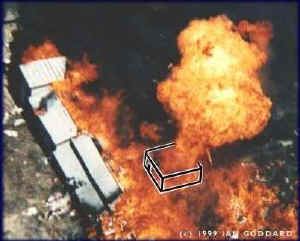Waco Unraveling No. 5
Ian Goddard has provided us some information on some far-fetched theories.Gary Hunt,
Outpost of Freedom
September 29, 1999In Ian Goddard"s original presentation of Gordon Novel"s "The Concrete Tomb - Bomb" theory, he presents a very plausible explanation of the tactics used by the FBI (and others?) in entrapping women and children inside of what the FBI had described as a "bunker". The bunker was, in fact, the old "vault" in which the records of the Davidians had been kept when the building surrounding it was the Church office. A fire destroyed the building and caused a collapse in the ceiling of the vault, probably as a result of the high heat generated by the original fire, among other factors.
Subsequently, when the more recent Church building was constructed, it was built around the old vault. Materials for the new Church were comprised of the materials salvaged from the twelve houses that once existed just North of the building we became so familiar with in 1993. The vault was incorporated in the design and was located just off of the kitchen, within the four story tower. It was used as a sort of pantry/cooler for the storage of vegetables and other foods.
One of Novel"s theories revolves around an explosion that occurred during the fire that consumed Mt. Carmel Center, Waco, Texas, on April 19, 1993. As Goddard begins his presentation of the Novel Theory, he cites both Gordon Novel and Brigadier General Benton Partin (Ret.) He begins his demonstration of the theory with the following:
"A primary feature of Novel"s bomb theory is the large fireball that appeared during the fire. When the concrete room is superimposed in its exact location over the following FBI photograph of the fireball, we can see that the fireball originated exactly on top of the room."
This, he supported with the following image:
Goddard has imposed his perceived location of the "cooler" (base of the four story tower) in this image. He explains that the explosion is from the "exact location" of the "concrete room". The location used by Goddard may have the building located directly under the explosion, however a review of other sources of information might lead one to conclude that the explosion came from behind the tower, and, perhaps, off to the side, slightly.


